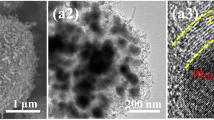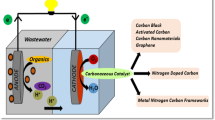Abstract
Magnetite (Fe3O4) nanoparticles anchored over the different active carbon supports were developed by a simple wet solution method. The developed nanostructures were magnetically self-assembled over the electrode surface and exploited as anode catalysts in mediatorless microbial fuel cells (MFC). The morphological characterizations revealed that 3∼8-nm-sized Fe3O4 nanoparticles were homogeneously anchored over the different carbon matrices and the obtained diffraction patterns ensured the cubic inverse spinel structure of prepared Fe3O4 nanoparticles. The morphology, size, and structure of Fe3O4 nanoparticles anchored over the different active carbon supports were maintained identical, and the influence of active carbon support toward the effectual MFC performances was evaluated under various electrochemical regimes and conditions by using Escherichia coli as a catalytic microorganism. The electrochemical characterizations revealed that carbon nanotube (CNT)-supported Fe3O4 nanoparticles exhibited lower charge transfer resistance and high coulombic efficiency in comparison with the graphene and graphite nanofiber-supported composites. Among the studied anode catalysts, Fe3O4/CNT composite exhibited the maximum MFC power density of 865 mW m−2 associated with excellent durability performances, owing to the specific interaction exerted between the microorganisms and the Fe3O4/CNT composite. Thus, the binder-free electrode modification process, mediatorless environment, rapid electron transfer kinetics, high power generation, and long durability performances achieved for the developed system paved futuristic dimensions for the high performance MFCs.







Similar content being viewed by others
References
Wang, H., Park, J. D., & Ren, Z. J. (2015). Practical energy harvesting for microbial fuel cells: a review. Environmental Science and Technology, 49(6), 3267–3277.
Kumar, G. G., Kirubaharan, C. J., Udhayakumar, S., Karthikeyan, C., & Nahm, K. S. (2014). Conductive polymer/graphene supported platinum nanoparticles as anode catalysts for the extended power generation of microbial fuel cells. Industrial and Engineering Chemistry Research, 53(43), 16883–16893.
Kumar, G. G., Hashmi, S., Karthikeyan, C., Nejad, A. G., Varnoosfaderani, M. V., & Stadler, F. J. (2014). Graphene oxide/carbon nanotube composite hydrogels—versatile materials for microbial fuel cell applications. Macromolecular Rapid Communications, 35(21), 1861–1865.
Rahimnejad, M., Adhami, A., Darvari, S., Zirepour, A., & Oh, S. E. (2015). Microbial fuel cell as new technology for bioelectricity generation: a review. Alexandria Engineering Journal, 54(3), 745–756.
Choi, S. (2015). Microscale microbial fuel cells: advances and challenges. Biosensors and Bioelectronics, 69, 8–25.
Ho, P. I., Kumar, G. G., Kim, A. R., Kim, P., & Nahm, K. S. (2011). Microbial electricity generation of diversified carbonaceous electrodes under variable mediators. Bioelectrochemistry, 80(2), 99–104.
Abrevaya, X. C., Sacco, N. J., Bonetto, M. C., Ohlsson, A. H., & Cortón, E. (2015). Analytical applications of microbial fuel cells. Part I: biochemical oxygen demand. Biosensors and Bioelectronics, 63, 580–590.
Chen, B. Y., Xu, B., Yueh, P. L., Han, K., Qin, L. J., & Hsueh, C. C. (2015). Deciphering electron-shuttling characteristics of thionine-based textile dyes in microbial fuel cells. Journal of the Taiwan Institute of Chemical Engineers, 51(4), 63–70.
Miroliaei, M. R., Samimi, A., Kalhori, D. M., Khorram, M., & Qasemi, A. (2015). Competition between E. coli and Shewanella sp. for electricity generation in air cathode MFC in presence of methylene blue as artificial mediator. Environmental Progress & Sustainable Energy, 34(4), 1097–1105.
Al-Shehri, A. N. Z. (2015). Employment of microbial fuel cell technology to biodegrade naphthalene and benzidine for bioelectricity generation. International Journal of Current Microbiology and Applied Sciences, 4(1), 134–149.
Yang, Y., Ding, Y., Hu, Y., Cao, B., Rice, S. A., Kjelleberg, S., & Song, H. (2015). Enhancing bidirectional electron transfer of Shewanella oneidensis by a synthetic flavin pathway. ACS Synthetic Biology, 4(7), 815–823.
Khilari, S., Pandit, S., Varanasi, J. L., Das, D., & Pradhan, D. (2015). Bifunctional manganese ferrite/polyaniline hybrid as electrode material for enhanced energy recovery in microbial fuel cell. ACS Applied Materials & Interfaces, 7(37), 20657–20666.
Manzella, M. P., Reguera, G., & Kashefi, K. (2013). Extracellular electron transfer to Fe(III) oxides by the hyperthermophilic archaeon Geoglobus ahangari via a direct contact mechanism. Applied and Environment Microbiology, 79(15), 4694–4700.
Xu, P., Zeng, G. M., Huang, D. L., Feng, C. L., Hu, S., Zhao, M. H., Lai, C., Wei, Z., Huang, C., Xie, G. X., & Liu, Z. F. (2012). Use of iron oxide nanomaterials in wastewater treatment: a review. Science of the Total Environment, 424, 1–10.
Park, I. H., Christy, M., Kim, P., & Nahm, K. S. (2014). Enhanced electrical contact of microbes using Fe3O4/CNT nanocomposite anode in mediator-less microbial fuel cell. Biosensors and Bioelectronics, 58, 75–80.
Zhang, W., Li, X., Zou, R., Wu, H., Shi, H., Yu, S., & Liu, Y. (2015). Multifunctional glucose biosensors from Fe3O4 nanoparticles modified chitosan/graphene nanocomposites. Scientific Reports, 5, 1–9.
Huang, S., Gu, L., Zhu, N., Feng, K., Yuan, H., Lou, Z., Li, Y., & Shan, A. (2014). Heavy metal recovery from electroplating wastewater by synthesis of mixed-Fe3O4@SiO2/metal oxide magnetite photocatalysts. Green Chemistry, 16(5), 2696–2705.
Bock, D. C., Kirshenbaum, K. C., Wang, J., Zhang, W., Wang, F., Wang, J., Marschilok, A. C., Takeuchi, K. J., & Takeuchi, E. S. (2015). 2D cross sectional analysis and associated electrochemistry of composite electrodes containing dispersed agglomerates of nanocrystalline magnetite, Fe3O4. ACS Applied Materials & Interfaces, 7(24), 13457–13466.
Peng, X., Yu, H., Wang, X., Zhou, Q., Zhang, S., Geng, L., Sun, J., & Cai, Z. (2012). Enhanced performance and capacitance behavior of anode by rolling Fe3O4 into activated carbon in microbial fuel cells. Bioresource Technology, 121, 450–453.
Ji, J., Jia, Y., Wu, W., Bai, L., Ge, L., & Gu, Z. (2011). A layer-by-layer self-assembled Fe2O3 nanorod-based composite multilayer film on ITO anode in microbial fuel cell. Colloids and Surfaces A: Physicochemical and Engineering Aspects, 390(1–3), 56–61.
Wang, P., Li, H., & Du, Z. (2013). Deposition of iron on graphite felts by thermal decomposition of Fe(CO)5 for anodic modification of microbial fuel cells. International Journal of Electrochemical Science, 8(4), 4712–4722.
Huang, J., Zhu, N., Yang, T., Zhang, T., Wu, P., & Dang, Z. (2015). Nickel oxide and carbon nanotube composite (NiO/CNT) as a novel cathode non-precious metal catalyst in microbial fuel cells. Biosensors and Bioelectronics, 72(5), 332–339.
Yuan, H., & He, Z. (2015). Graphene-modified electrodes for enhancing the performance of microbial fuel cells. Nanoscale, 7(16), 7022–7029.
Peera, S. G., Sahu, A. K., Arunchander, A., Bhat, S. D., Karthikeyan, J., & Murugan, P. (2015). Nitrogen and fluorine co-doped graphite nanofibers as high durable oxygen reduction catalyst in acidic media for polymer electrolyte fuel cells. Carbon, 93(3), 130–142.
Zhang, J., Zhang, M., Lin, L., & Wang, X. (2015). Sol processing of conjugated carbon nitride powders for thin-film fabrication. Angewandte Chemie International Edition in English, 54(21), 6297–6301.
Kumar, G. G., Kirubaharan, C. J., Udhayakumar, S., Ramachandran, K., Karthikeyan, C., Renganathan, R., & Nahm, K. S. (2014). Synthesis, structural, and morphological characterizations of reduced graphene oxide-supported polypyrrole anode catalysts for improved microbial fuel cell performances. ACS Sustainable Chemistry and Engineering, 2(10), 2283–2290.
Chen, X. H., Lu, X. N., Deng, F. M., Wu, G. T., Wang, M., Yang, H. S., Zhang, X. B., Peng, J. C., & Li, W. Z. (2001). Growth of well-crystallized segmented graphite nanofibers by catalytic chemical vapor deposition. Journal of Crystal Growth, 222(1-2), 163–169.
Ju, H. M., Choi, S. H., & Huh, S. H. (2010). X-ray diffraction patterns of thermally-reduced graphenes. Journal of the Korean Chemical Society, 57(6), 1649–1652.
Li, W., Liang, C., Zhou, W., Qiu, J., Zhou, Z., Sun, G., & Xin, Q. (2000). Preparation and characterization of multiwalled carbon nanotube-supported platinum for cathode catalysts of direct methanol fuel cells. Journal of Physical Chemistry B, 107(26), 6292–6299.
Namvari, M., & Namazi, H. (2014). Clicking graphene oxide and Fe3O4 nanoparticles together: an efficient adsorbent to remove dyes from aqueous solutions. International Journal of Environmental Science and Technology, 11(6), 1527–1536.
Xie, X., Hu, L., Pasta, M., Wells, G. F., Kong, D., Criddle, C. S., & Cui, Y. (2015). Three-dimensional carbon nanotube-textile anode for high-performance microbial fuel cells. Nano Letters, 11(1), 291–296.
Qu, S., Wang, J., Kong, J., Yang, P., & Chen, G. (2007). Magnetic loading of carbon nanotube/nano-Fe3O4 composite for electrochemical sensing. Talanta, 71(3), 1096–1102.
Sun, X., Wang, G., Hwang, J. Y., & Lian, J. (2011). Porous nickel oxide nano-sheets for high performance pseudocapacitance materials. Journal of Materials Chemistry, 21(41), 16581–16588.
Wang, Y., Li, B., Cui, D., Xiang, X., & Li, W. (2014). Nano-molybdenum carbide/carbon nanotubes composite as bifunctional anode catalyst for high-performance Escherichia coli-based microbial fuel cell. Biosensors and Bioelectronics, 51, 349–355.
Naidek, K. P., Bianconi, F., Rocha, T. C. R., Zanchet, D., Bonacin, J. A., Novak, M. A., Vaz, M. G. F., & Winnischofer, H. (2011). Structure and morphology of spinel MFe2O4 (M = Fe, Co, Ni) nanoparticles chemically synthesized from heterometallic complexes. Journal of Colloid and Interface Science, 358(1), 39–46.
Li, Y., & Shen, W. (2014). Morphology-dependent nanocatalysts: rod-shaped oxides. Chemical Society Reviews, 43(5), 1543–1574.
Yi, H., Nevin, K. P., Kim, B. C., Franks, A. E., Klimes, A., Tender, L. M., & Lovley, D. R. (2009). Selection of a variant of Geobacter sulfurreducens with enhanced capacity for current production in microbial fuel cells. Biosensors and Bioelectronics, 24(12), 3498–3503.
Zou, Y., Xiang, C., Yang, L., Sun, L. X., Xu, F., & Cao, Z. (2008). A mediatorless microbial fuel cell using polypyrrole coated carbon nanotubes composite as anode material. International Journal of Hydrogen Energy, 33(18), 4856–4862.
Zhang, Y., Mo, G., Li, X., Zhang, W., Zhang, J., Ye, J., Huang, X., & Yu, C. (2011). A graphene modified anode to improve the performance of microbial fuel cells. Journal of Power Sources, 196(13), 5402–5407.
Gurunathan, S., Han, J. W., Dayem, A. A., Eppakayala, V., & Kim, J. H. (2012). Oxidative stress-mediated antibacterial activity of graphene oxide and reduced graphene oxide in Pseudomonas aeruginosa. International Journal of Nanomedicine, 7, 5901–5914.
Akhavan, O., & Ghaderi, E. (2010). Toxicity of graphene and graphene oxide nanowalls against bacteria. ACS Nano, 4(10), 5731–5736.
Zou, X., Zhang, L., Wang, Z., & Luo, Y. (2016). Mechanisms of the antimicrobial activities of graphene materials. Journal of American Chemical Society, 138(7), 2064–2077.
Flexer, V., Chen, J., Donose, B. C., Sherrell, P., Wallace, G. G., & Keller, J. (2013). The nanostructure of three-dimensional scaffolds enhances the current density of microbial bioelectrochemical system. Energy and Environmental Science, 6(4), 1291–1298.
Roh, S. H. (2013). Layer-by-layer self-assembled carbon nanotube electrode for microbial fuel cells application. Journal of Nanoscience and Nanotechnology, 13(6), 4158–4161.
Reguera, G., McCarthy, K. D., Mehta, T., Nicoll, J. S., Tuominen, M. T., & Lovley, D. R. (2005). Extracellular electron transfer via microbial nanowires. Nature, 435(23), 1098–1101.
Reguera, G., Nevin, K. P., Nicoll, J. S., Covalla, S. F., Woodard, T. L., & Lovley, D. R. (2006). Biofilm and nanowire production leads to increased current in Geobacter sulfurreducens fuel cells. Applied and Environmental Microbiology, 72(11), 7345–7348.
Lovley, D. R. (2012). Electromicrobiology. Annual Review of Microbiology, 66, 391–409.
Acknowledgments
This work was supported by “Human Resources Program in Energy Technology” of the Korea Institute of Energy Technology Evaluation and Planning (KETEP), granted financial resource from the Ministry of Trade, Industry & Energy, Republic of Korea. (No. 20134030200330). This work was supported by the Science and Engineering Research Board (SERB), New Delhi, India - Major Project Grant No. EMR/2015/000912.
Author information
Authors and Affiliations
Corresponding authors
Rights and permissions
About this article
Cite this article
Park, I.H., Kim, P., Gnana kumar, G. et al. The Influence of Active Carbon Supports Toward the Electrocatalytic Behavior of Fe3O4 Nanoparticles for the Extended Energy Generation of Mediatorless Microbial Fuel Cells. Appl Biochem Biotechnol 179, 1170–1183 (2016). https://doi.org/10.1007/s12010-016-2057-0
Received:
Accepted:
Published:
Issue Date:
DOI: https://doi.org/10.1007/s12010-016-2057-0




